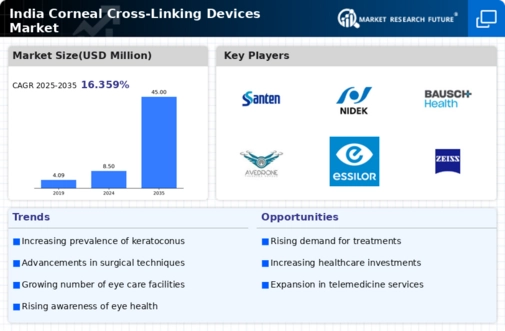Government Initiatives and Funding
Government initiatives aimed at improving eye care services in India are likely to bolster the corneal cross-linking-devices market. Various health programs and funding schemes have been introduced to enhance access to advanced ophthalmic treatments. For instance, the National Programme for Control of Blindness and Visual Impairment has allocated resources to promote awareness and treatment of corneal diseases. Such initiatives not only increase the availability of corneal cross-linking procedures but also encourage research and development in this field. The financial support from the government could potentially lead to a market growth of around 10% in the next few years, as more healthcare facilities adopt these technologies to meet rising patient demands.
Increasing Prevalence of Keratoconus
The rising incidence of keratoconus in India is a pivotal driver for the corneal cross-linking-devices market. Studies indicate that keratoconus affects approximately 1 in 500 individuals, leading to a growing demand for effective treatment options. As awareness of this condition increases, more patients seek interventions that can halt disease progression. The corneal cross-linking procedure has emerged as a preferred treatment, as it strengthens corneal tissue and improves visual acuity. This trend is likely to propel the market forward, with estimates suggesting a potential growth rate of 15% annually in the coming years. The increasing number of ophthalmic clinics offering this treatment further supports market expansion, as accessibility improves across urban and rural areas.
Technological Innovations in Treatment
Technological advancements in corneal cross-linking devices are significantly influencing the market landscape. Innovations such as the development of faster and more efficient devices, including those utilizing UV light and riboflavin solutions, enhance treatment efficacy and patient comfort. The introduction of minimally invasive techniques is also noteworthy, as they reduce recovery time and improve patient outcomes. As these technologies become more prevalent, the corneal cross-linking-devices market is expected to experience substantial growth. Market analysts project that the adoption of advanced devices could lead to a market increase of approximately 20% over the next five years. This trend reflects a broader shift towards precision medicine in ophthalmology, aligning with patient-centric care models.
Rising Disposable Income and Healthcare Expenditure
The increase in disposable income among the Indian population is a crucial driver for the corneal cross-linking-devices market. As individuals have more financial resources, they are more likely to invest in healthcare services, including advanced eye treatments. The growing middle class, with an increasing focus on health and wellness, is driving demand for effective solutions to eye disorders. Furthermore, healthcare expenditure in India has been on the rise, with projections indicating a growth rate of 12% annually. This trend suggests that more patients will seek corneal cross-linking procedures, thereby expanding the market. The willingness to pay for quality healthcare services is likely to enhance the adoption of corneal cross-linking devices across various demographics.
Collaboration Between Healthcare Providers and Manufacturers
Collaborative efforts between healthcare providers and manufacturers are emerging as a significant driver for the corneal cross-linking-devices market. Partnerships facilitate the sharing of knowledge and resources, leading to improved product development and enhanced treatment protocols. Such collaborations often result in training programs for healthcare professionals, ensuring they are well-versed in the latest techniques and technologies. This synergy not only boosts the quality of care but also increases the market's credibility. As more healthcare institutions align with manufacturers to offer cutting-edge treatments, the corneal cross-linking-devices market is poised for growth. Analysts suggest that these partnerships could contribute to a market expansion of approximately 15% over the next few years, as they enhance service delivery and patient outcomes.




















Leave a Comment